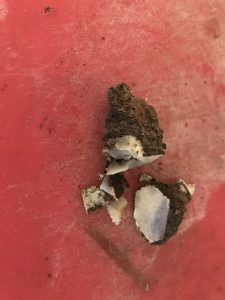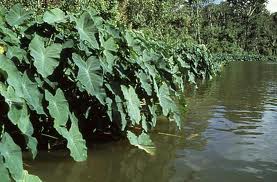IS WILD TARO IN FLORIDA EDIBLE?
Started August 2011
“Wild Taro.” My research to date:
Is the wild taro in Florida edible? In one word, no. In two… may… be….
It is doubtful the roots of the Colocasia esculenta var. aquatilis — the taro clogging Florida’s waterways — can be reasonably rid of their acid content. The young leaves, however, might be made subacid.
Background:
Edible taro has calcium oxalate that has to be eliminated by cooking before eating, either by boiling or baking or drying. There may be other chemicals at work as well under the acid umbrella which may mask what is actually happening.
Interestingly, recent academic assertions suggests the edible, cultivated taro, Colosasia esculenta is a descendant of the Colosasia aquatilis, not the other way around. If that is the case the cultivated version should more properly be named Colocasia aquatilis var. esculenta
I think the state of Florida makes an essential mistake when reporting the effects of the escaped taro on the state’s waterways. The tenor of the articles are that C. esculenta was imported and encouraged. Then it escaped and is clogging the water ways and, by the way, its roots have an acid and must be prepared correctly.
If the “wild taro” in Florida’s waterways is an escaped C. esculenta one should be able to cook it to the point of being non-acid. Cooking instructions for C. esculenta are boil roots and or leaves 45 minutes. This definitely does not work with Colocasia esculenta var. aquatilis. And that would make sense if in fact their lineage is reverse, that the cultivated less-acidic taro is a tamer version of the “wild” very acidic taro.
On two occasions I collected “wild taro” (C. aquatilis) from the St. John’s River in Sanford and the Wekiva River, at the Wekiva Marina. Boiling those chopped tiny roots for two hours in three changes of water did not eliminated the acid. Baking root chips for 30 minutes at 350F didn’t either.
Thus far I have:
1) Boiled peeled young roots size of large marbles for one hours, still acidic, which means burning the lips, tongue, mouth and inner skin of the elbow and finger webs.
2) Boiled various sizes of root sliced, none more than 1/4 thick or 3/4 inches across. Those I boiled for two hours in three changes of water at 30, 60, and 90 minutes, total actual boiling time 150 minutes (the other 30 minutes heating the water to boil again.) All parts, even small pieces, still were acidic. If it were C. esculenta the acid should have been gone by then. Thus Colocasia esculenta var. aquatilis is made of sterner stuff (said cole-oh-KAY-shah. ess-kew-LEN-tah variation a-KWA-ti-lis.)
3) I have baked peeled thin chips (like home-made potato chips, raw taro root rebels against slicing on a mandolin ) at 30 minutes at 350F, small, dark brown chip (incinerated) no immediate hint of acid. Larger tan chips at 30 minutes at 350F produce, after chewing, a hint of nasturtium odor and tingle to the nose and then mouth burn within half a minute. A mouth rinse with lemon juice put the fire out but my mouth was mildly sore for several hours.
4) Chips baked for an hour at 350F became cinders. I have not tried a slow, low roast for several hours. A tiny root baked unpeeled for three hours at 350 had no immediate burn on inner elbow skin. It was too unappealing for a mouth test. So much for the roots.
Another next step is to roast large roots on moderate heat for two hours then grate them. Then soak them for a full day changing the water often. We’ll see how that works. It is similar to what the aborigines do in Australia with a yam that has calcium oxalates in it, except they stick the roasted, grated yam in a river for a day to leach.
5) Young leaves (under six inches inner clef to tip) boiled one hour with a change of water at 30 minutes, still acidic. Boiled for two hours in three changes of water no apparent acid, but petiole (stem) near blade (leaf) was still acidic. Repeated minus stem: Boiled two hours, water changes at 30, 60 and 90 minutes, total boiling time 150 minutes (30 to heat water after two changes.) Young leaves treated that way appear to lose their contact acid. Taste mild, if not pleasant, no oral burn. Did not consume. Edibility of the leaves of Florida’s version is unknown. Even if long-boiled leaves are edible the energy expenditure for the energy/nutritional value gained would be quite negative.

Cooked Colocasia esculenta var. aquatilis photo by Green DSeane

Uncooked Colocasia esculenta var. aquatilis. Photo by Green Deane
6)I dug up a small corm, April 2022. It was peppery raw. After roasting an hour at 350F it was soft and flavoful but still peppery.Perhaps what natives did with other plants with calcium oxalates is bury it and build a fire over it for several days.
7) Another possibility is to try drying the leaves, and or leaves and petioles separated. See below.
8) Internet searching produced a Japanese monograph (1) in 2002 about C. aquatilis in northern Vietnam. In the abstract it states: The uses and habitats of C. esculenta var. aquatilis were linked to the agroecosystems of the delta. The plant was frequently found around canals and farmers’ ponds in the delta, and its petioles and stolons were harvested for human consumption and pig fodder.
Petioles and stolens, read stems and spaghetti-like rootlets. This might be worth more investigation, and it would have been nice if methods of collection, preparation and cooking were included. I did not cook any stolons, using corms only, and I tried the top of only one young petiole.
First, the stolons are hard to clean, or at least the ones found in the Wekiva are, mucky like cattail roots. Next, of course, is the conflict between their report and my own experiment. I found long-boiled boiled leaves non-acidic and the stem (petiol) acidic. They make no mention of leaves and say the stems are edible. Of course the state of acid and edibility are two different issues, perhaps related but not necessarily so. Even if the Florida version could be rendered acid-less that is no indication of edibility just absence of acid.
(1) Tropical agriculture: Japanese journal of tropical agriculture Japanese journal of tropical agriculture: Vol.46, No.4(20021201) pp. 247-258 Vol.46, No.4 (20021201) pp. 247-258: 日本熱帯農業学会 ISSN:00215260 Japan Society for Tropical Agriculture ISSN: 00215260


